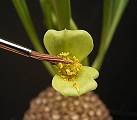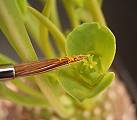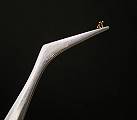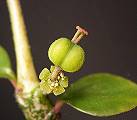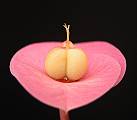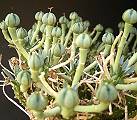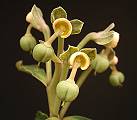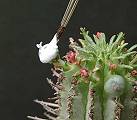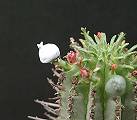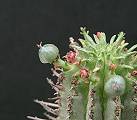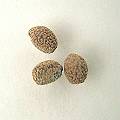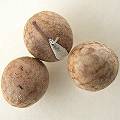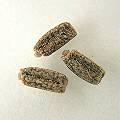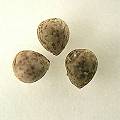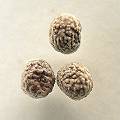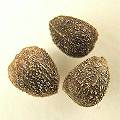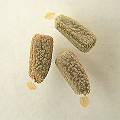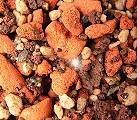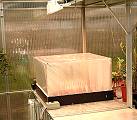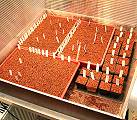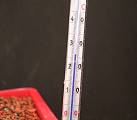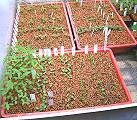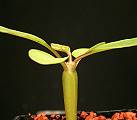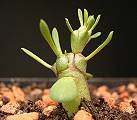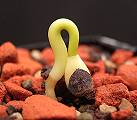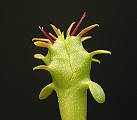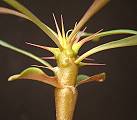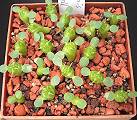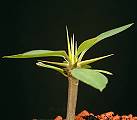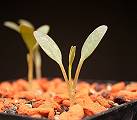Producing, harvesting and sowing seed
As
euphorbia seeds have a limited shelf-life, they are rarely offered
commercially.
Pollination
can be achieved using a brush with fine hair, and transferring the ripe pollen
from one cyathium (flower) to the stigma of that of another plant. Be sure to
clean the brush thoroughly after use to avoid unexpected hybrids! Another way
is to remove ripe stamens using fine tweezers and using them immediately to
effect a pollination.
|
Pollination of Euphorbia bupleurifolia |
||
|
Taking pollen of a male plant |
Transferring pollen to the stigma |
Using tweezers |
Harvesting
seeds presents a problem. The fruits of euphorbias are hard, woody capsules,
made up of three segments, each containing a relatively large seed. When the
capsule ripens, it explodes and scatters the seeds over amazing distances. A
tried and tested method is to put a cotton pad around the ripening capsule and
so prevent the seed from flying away. Nylon stockings can be used in the same
way. In the case of particularly valuable seed, the whole plant can be enclosed
in thin gauze or nylon.
|
Seed capsules |
|||
|
Euphorbia bemaharaensis |
Euphorbia geroldii |
Euphorbia maleolens |
Monadenium pseudoracemosum |
A
convenient and safer method to save the seed is to apply a thin layer of glue to
the already ripened capsules to prevent them bursting open. Fully dried
capsules can sometimes be collected whole and opened carefully from the base.
|
Euphorbia and Monadenium seed Each photo shows an area of 7 x 7 mm |
|||
|
Euphorbia alfredii |
Euphorbia groenewaldii |
Euphorbia lupulina |
Euphorbia meloformis |
|
|
|
|
|
|
Euphorbia nubigena |
Euphorbia pugniformis |
Monadenium coccineum |
Monadenium mafingensis |
Containers
suitable for sowing are above all shallow plastic pots or trays as they do not
dry out so quickly and can easily be cleaned and disinfected. The sowing medium
should be light and poorer in nutrients than normal commercial plant compost. A
mineral soil can also be used, such as fine to medium grade sand to which can
be added a little finely sifted peat. The soil should be thoroughly wetted by
standing the containers in water.
As
conditions in the containers are also favourable for fungus growth,
sterilisation of the soil is recommended (about 20 minutes in an oven at 120 °C
with the soil evenly spread on a sheet). The soil can also be disinfected with
a fungicide such as Chinosol, but please read the directions carefully or the
tender seedlings may be damaged as they germinate.
Sow the seeds
evenly and not too thickly on the surface of the soil, press lightly and cover
with a very thin layer of soil or sand no more than twice the thickness of the
seeds.
During
the period of germination, always keep the soil moist as letting the soil dry
even once can result in heavy losses. It can be helpful to cover the trays with
a transparent plastic dome or cling film.
The
temperature at night should not go below 18 °C, although by day it can rise as
high as 40 °C. 25 °C is ideal. Basically higher temperatures bring faster
germination, but full sun should be avoided to prevent the young seedlings
scorching.
The short
viability of euphorbia seeds should be noted. The percentage germination can
fall to 50% after only a few weeks. In general seed needs to be dry and stored at
5 °C in air and water proof containers. Dampness or higher temperatures cause
the viability to decline more quickly.
As
rainfall is irregular in habitat, not all seed germinates at the same time to
ensure some seedlings survive. Germination tends to occur in waves, for example
after one week, 8 weeks and 15 weeks. Furthermore, the germination period also
varies from species to species.
|
Seedlings |
|||
|
Euphorbia alfredii |
Euphorbia brevirama |
Euphorbia bubalina |
Euphorbia enopla |
|
|
|
|
|
|
Euphorbia gottlebei |
Euphorbia meloformis |
Euphorbia rossii |
Euphorbia thinophila |
